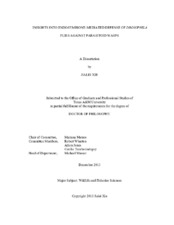| dc.description.abstract | Maternally-transmitted associations between endosymbiotic bacteria and insects are diverse and widespread in nature. To counter loss by imperfect vertical transmission, many heritable microbes have evolved compensational mechanisms, such as manipulating host reproduction and conferring fitness benefits to their hosts. Symbiont-mediated defense against natural enemies of hosts is increasingly recognized as an important mechanism by which endosymbionts enhance host fitness. Members of the genus Spiroplasma associated with distantly related Drosophila, are known to engage in either reproductive parasitism (i.e., male killing, MSRO strain) or defense against natural enemies (a parasitic wasp and a nematode). My previous studies indicate the Spiroplasma hy1 enhances survival of Drosophila hydei against the parasitoid wasp Leptopilina heterotoma, but whether this phenomenon can contribute to the long-term persistence of Spiroplasma is not clear. Here, I tracked Spiroplasma frequencies in fly lab populations repeatedly exposed to high or no wasp parasitism throughout ten generations. A dramatic increase of Spiroplasma prevalence was observed under high wasp pressure. In contrast, Spiroplasma prevalence in the absence of wasps did not change significantly over time; a pattern consistent with random drift. Thus, the defensive mechanism may contribute to the high prevalence of Spiroplasma in D. hydei populations despite imperfect vertical transmission.
A male-killing strain of Spiroplasma (MSRO), closely related to strain hy1, associates with the model organism D. melanogaster, and co-occurs with Wolbachia (strain wMel) in certain wild populations. We examined the effects of Spiroplasma MSRO and Wolbachia wMel, on Drosophila survival against parasitism by two common wasps, L. heterotoma and L. boulardi, that differ in their host ranges and host evasion strategies. The results indicate that Spiroplasma MSRO prevents successful development of both wasps, and confers a small, albeit significant, increase in larva-to-adult survival of flies subjected to wasp attacks. We modeled the conditions under which defense can contribute to Spiroplasma persistence. Wolbachia also confers a weak, but significant, survival advantage to flies attacked by L. heterotoma. This additive protective effect of Spiroplasma and Wolbachia may provide conditions for such co-transmitted symbionts to become mutualists. Occurrence of Spiroplasma-mediated protection against distinct parasitoids in divergent Drosophila hosts implies a general protection mechanism. | en |


